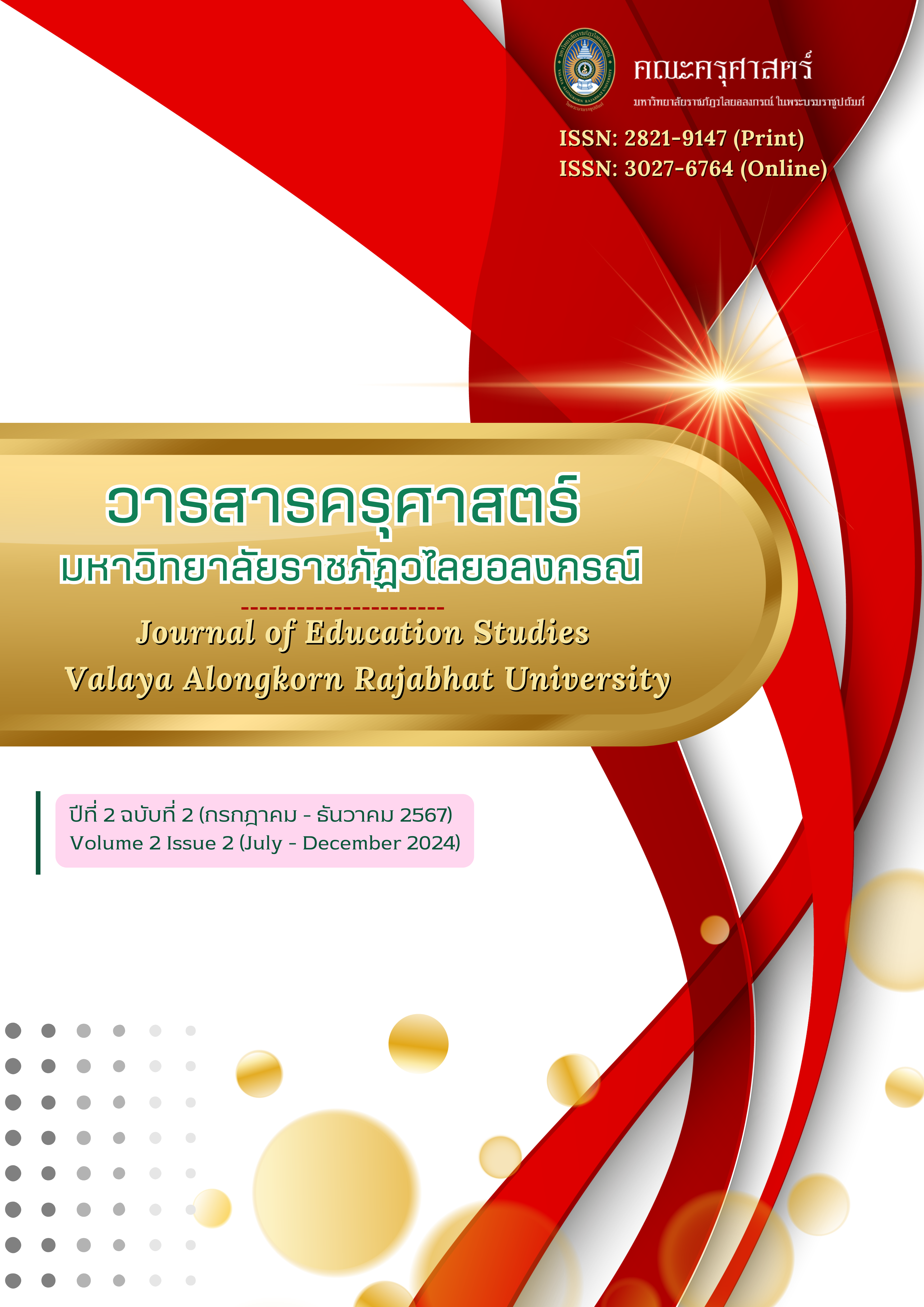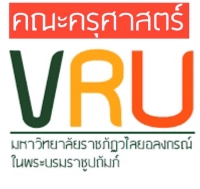The Development of Mathematics Learning Achievements on Integers among Mathayomsuksa 1 Students by Using Activity-Based Learning Management Integrated with Learning Together (LT) Technique
Keywords:
Activity-Based Learning, Learning Together Technique, Mathematics Learning Achievement, Adding IntegersAbstract
The objectives of this research were 1) to compare the mathematics learning achievement on integers of Mathayomsuksa 1 students before and after receiving the activity-based learning management integrated with learning together (LT) technique, and 2) to compare the mathematics learning achievement on integers of Mathayomsuksa 1 students after receiving the activity-based learning management integrated with learning together (LT) technique with the criteria of 60 percent. The sample for this research consisted of 29 Mathayomsuksa 1 students at Kanchanapisekwittayalai Chachoengsao School during the first semester of the academic year 2023, which was obtained by cluster random sampling. The research instruments were lesson plans designed using the activity-based learning integrated with learning together (LT) technique, and mathematics learning achievement tests for pretest and posttest. The statistics used in the research were mean, standard deviation, t-test for dependent sample, and t-test for one sample.
The results of this research are as follows:
- The mathematics learning achievement on integers of Mathayomsuksa 1 students after receiving the activity-based learning management integrated with learning together (LT) technique was higher than before, with statistical significance at the .01 level.
- The mathematics learning achievement on integers of Mathayomsuksa 1 students after receiving the activity-based learning management integrated with learning together (LT) technique was higher than the criteria of 60 percent, with statistical significance at the .01 level.
References
กฤษฎา วรพิน, อรรฆพร วงษ์ประดิษฐ์, สุบิน ยมบ้านกวย และสาธิต จันทรวินิจ. (2565). การเรียนรู้โดยใช้กิจกรรมเป็นฐานในชั้นเรียนวิชาคณิตศาสตร์. วารสารศึกษาศาสตร์ มหาวิทยาลัยศิลปากร, 20(1), 31-46.
จินตนา ศิริธัญญารัตน์ และวัชรา เหล่าดี. (2562). การออกแบบระบบการเรียนการสอน. นครปฐม: โรงพิมพ์ มหาวิทยาลัยศิลปากร.
จุฑามณี อินทร์อุริศ และชมนาด เชื้อสุวรรณทวี. (2565). การจัดการเรียนรู้โดยใช้กิจกรรมเป็นฐานร่วมกับการเรียนรู้แบบร่วมมือที่มีต่อความสามารถในการแก้ปัญหาทางคณิตศาสตร์และผลสัมฤทธิ์ทางการเรียน เรื่อง สมการเชิงเส้นตัวแปรเดียว ของนักเรียนชั้นมัธยมศึกษาปีที่ 1 โรงเรียนสาธิตมหาวิทยาลัยศรีนครินทรวิโรฒ ประสานมิตร (ฝ่ายมัธยม). วารสารมหาจุฬานาครทรรศน์, 9(5), 186-197.
จุติพร บางจักร และวรรณภร ศิริพละ (2562). การศึกษาผลสัมฤทธิ์ทางการเรียนวิชาคณิตศาสตร์ เรื่อง ทศนิยม ของนักเรียนชั้นมัธยมศึกษาปีที่ 1 โดยใช้การเรียนรู้แบบร่วมมือเทคนิค LT. วารสารวิชาการครุศาสตร์สวนสุนันทา, 3(1), 46-56.
ชนสิทธิ์ สิทธิ์สูงเนิน, สุวิมล สพฤกษ์ศรี, สราญจิต อันพา, บุญรอด ชาติยานนท์, เอกสิทธิ์ ชนินทรภูมิ และเสกสรร สุขเสนา. (2565). การจัดการเรียนรู้ด้วยกิจกรรมเป็นฐานร่วมกับเทคโนโลยีเพื่อส่งเสริมความเป็นนวัตกรและผลงานสร้างสรรค์สำหรับนักเรียน. มนุษยสังคมสาร, 20(2), 89-110.
ชมนาด เชื้อสุวรรณวี. (2561). การเรียนการสอนคณิตศาสตร์. กรุงเทพฯ: โรงพิมพ์แห่งจุฬาลงกรณ์มหาวิทยาลัย.
ทิศนา แขมมณี. (2563). ศาสตร์การสอน: องค์ความรู้เพื่อการจัดกระบวนการเรียนรู้ที่มีประสิทธิภาพ (พิมพ์ครั้งที่ 24). สำนักพิมพ์จุฬาลงกรณ์มหาวิทยาลัย.
ภริดา แก้วโต, อุไรวรรณ ปานทโชติ และสายพิน ปรักมาส. (2561). ผลการจัดกิจกรรมการเรียนรู้เรื่องอสมการโดยใช้การจัดการเรียนการสอนโดยใช้เทคนิค Learning Together (LT) ของนักเรียนชั้นมัธยม ศึกษาปีที่ 3. กำแพงเพชร: คณะครุศาสตร์ มหาวิทยาลัยราชภัฏกําแพงเพชร.
วรรณวิสา สุวรรณชัยรบ, ต้องตา สมใจเพ็ง และชานนท์ จันทรา. (2564). ผลการจัดการเรียนรู้โดยใช้กิจกรรมเป็นฐานร่วมกับกลวิธีเชิงอภิปัญญาที่มีต่อความสามารถในการให้เหตุผลทางคณิตศาสตร์ของนักเรียนชั้นมัธยมศึกษาปีที่ 3 เรื่อง ความน่าจะเป็น. วารสารมหาจุฬานาครทรรศน์, 8(1), 214-228.
ศิริพร พุ่มพวง และนันทพร ชื่นสุพันธรัตน์. (2563). ผลการจัดการเรียนรู้วิชาคณิตศาสตร์และความคงทนในการเรียนรู้ เรื่อง อสมการ ของนักเรียนชั้นมัธยมศึกษาปีที่ 3 โดยใช้การจัดการเรียนรู้แบบร่วมมือเทคนิค TGT. วารสารสถาบันวิจัยและพัฒนา มหาวิทยาลัยราชภัฏบ้านสมเด็จเจ้าพระยา, 5(2), 1-11.
สำนักงานคณะกรรมการการศึกษาขั้นพื้นฐาน. (2562). แนวทางการนิเทศเพื่อพัฒนาและส่งเสริมการจัดการเรียนรู้เชิงรุก (Active Learning) ตามนโยบายลดเวลาเรียนเพิ่มเวลาเรียน. กรุงเทพฯ: กระทรวงศึกษาธิการ.
อรญา เติมโพก และปุณยพล จันทร์ฝอย. (2563). การเปรียบเทียบผลสัมฤทธิ์ทางการเรียนวิชาคณิตศาสตร์ เรื่อง เส้นขนาน โดยการจัดการเรียนรู้แบบร่วมมือโดยใช้เทคนิคจิ๊กซอว์ ของนักเรียนชั้นมัธยมศึกษา ปีที่ 2. วารสารวิชาการครุศาสตร์สวนสุนันทา, 4(2), 34-39.
อัมพร ม้าคะนอง. (2558). คณิตศาสตร์สำหรับครูมัธยม (พิมพ์ครั้งที่ 2). กรุงเทพฯ: โรงพิมพ์แห่งจุฬาลงกรณ์มหาวิทยาลัย.
Gillies, R. M. (2002). The residual effects of cooperative-learning experiences: a two-year follow-up. The Journal of Educational Research, 96(1), 15-20.
Hobri, H., Dafik, D., & Hossain, A. (2018). The implementation of learning together in improving students’ mathematical performance. International Journal of Instruction, 11(2), 483-496.
Noreen, R. (2018). A comparative study of effects of activity based teaching and traditional method teaching in mathematics at elementary level [Doctoral dissertation]. University of Lahore. https://prr.hec.gov.pk/jspui/handle/123456789/12292
Ray, P. K. (2022). Impact of activity based approaches on mathematics learning in secondary schools. International Journal of Special Education, 37(3), 5616-5627.
Yemi, T., Azid, N., & Ali, M. R. (2018). Cooperative learning: an approach for teaching mathematics in public school. European Journal of Social Sciences Studies, 2(10), 122-133.





